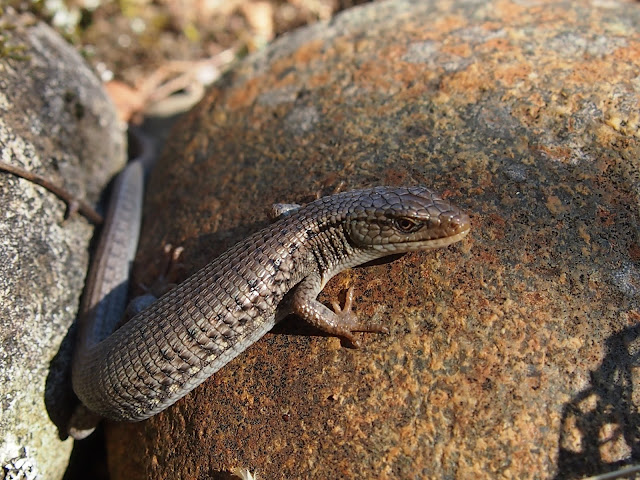We've had some interesting visitors at our place lately.
The first has become a regular who you may have read about before...

Georgia has befriended a few young deer, these being the smallest...

They are equally curious of one another...(not the best photos...taken with my iphone)


And here she's sharing a bowl of water we put out for the deer because of the drought and heat...



Then the other evening I was looking for something in the grass when I spotted this little creature...

She/he is a Northwestern Alligator Lizard, here's a few facts about them...
Scientific name: Elgaria coerulea principis
The Northwestern Alligator Lizard is a short-legged, long-bodied lizard, with a triangular head (bearing little resemblance to an actual alligator!). Growing to a maximum of 20 cm in total length, their size and colouration make them quite cryptic. Adults usually are brown in colour with a pale belly. Occasionally they sport dark blotches or a broad bronzy stripe down the centre of the back. Upon close examination, you might see a fold of skin running down each side. This allows the body to expand when the lizard is breathing, full of food, or in the case of females, full of eggs. Juveniles often are more metallic looking, with black sides and a bronze back.
Alligator Lizards are very secretive; their first defence is to flee and hide. If caught, a lizard may release a smelly mix of feces and musk, bite, or even ‘release’ (autotomize) its tail. The dropped tail acts as a decoy, distracting the potential predator. Over time, the lizard will regenerate a shorter, fatter tail. As the tail is an important fat reserve, tail autotomy usually is a tactic of last resort. As evidenced by the number of lizards with regenerated tails, however, it also is a successful tactic.
I took these photos while it just sat there sunning itself in the evening light...

I love their little mouth and their head looks like a snake.
I noticed afterward while looking at my photos that it was missing a toe!

...there's that tail that can break off...

Our other recent visitor is this guy...
It took a few attempts but I finally got a pretty good picture of him.
He's a Long Eared brown bat.
Can't you tell where they get their name?
Look at those ears!!
We found him while we were working up in the loft of our barn.
They feed on moths and have a pretty decent set of teeth from other photos I found on the web.
So there you go...a few of our furry friends that live around here.
All creatures great and small.


3 comments:
You have quite the collection of animals. I love the photos of the kitty and deer.
I'm amazed at the good close-ups you got of the lizard and bat!!
You live in an amazing place. :) Thanks for giving us a look-see.
I miss the bats,- good pic! we had so many on arriving here. But we find it is cyclical here too, as this year the barn swallows are back in huge qauntities, as are the doves, like our first year.
Post a Comment